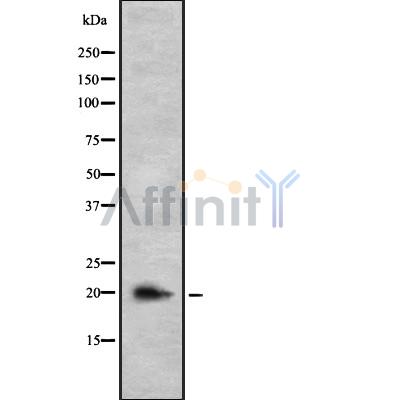IL26 Antibody - #DF8983
| Product: | IL26 Antibody |
| Catalog: | DF8983 |
| Description: | Rabbit polyclonal antibody to IL26 |
| Application: | WB IF/ICC |
| Reactivity: | Human, Monkey |
| Prediction: | Pig, Rabbit |
| Mol.Wt.: | 20 kDa; 20kD(Calculated). |
| Uniprot: | Q9NPH9 |
| RRID: | AB_2842179 |
Related Downloads
Protocols
Product Info
*The optimal dilutions should be determined by the end user. For optimal experimental results, antibody reuse is not recommended.
*Tips:
WB: For western blot detection of denatured protein samples. IHC: For immunohistochemical detection of paraffin sections (IHC-p) or frozen sections (IHC-f) of tissue samples. IF/ICC: For immunofluorescence detection of cell samples. ELISA(peptide): For ELISA detection of antigenic peptide.
Cite Format: Affinity Biosciences Cat# DF8983, RRID:AB_2842179.
Fold/Unfold
AK155; IL 26; IL-26; IL26; IL26_HUMAN; Interleukin 26; Interleukin-26; Protein AK155;
Immunogens
A synthesized peptide derived from human IL26, corresponding to a region within N-terminal amino acids.
Expressed in HVS transformed T-cells but not other T-cell lines or primary stimulated T-cells. Expressed in colonic T-cells including Th17 inflammatory T-cells; the expression is significantly increased in serum of patients with Crohn's disease (at protein level).
- Q9NPH9 IL26_HUMAN:
- Protein BLAST With
- NCBI/
- ExPASy/
- Uniprot
MLVNFILRCGLLLVTLSLAIAKHKQSSFTKSCYPRGTLSQAVDALYIKAAWLKATIPEDRIKNIRLLKKKTKKQFMKNCQFQEQLLSFFMEDVFGQLQLQGCKKIRFVEDFHSLRQKLSHCISCASSAREMKSITRMKRIFYRIGNKGIYKAISELDILLSWIKKLLESSQ
Predictions
Score>80(red) has high confidence and is suggested to be used for WB detection. *The prediction model is mainly based on the alignment of immunogen sequences, the results are for reference only, not as the basis of quality assurance.
High(score>80) Medium(80>score>50) Low(score<50) No confidence
Research Backgrounds
May play a role in local mechanisms of mucosal immunity and seems to have a proinflammatory function. May play a role in inflammatory bowel disease. Activates STAT1 and STAT3, MAPK1/3 (ERK1/2), JUN and AKT. Induces expression of SOCS3, TNF-alpha and IL-8, secretion of IL-8 and IL-10 and surface expression of ICAM1. Decreases proliferation of intestinal epithelial cells. Is inhibited by heparin.
Secreted.
Expressed in HVS transformed T-cells but not other T-cell lines or primary stimulated T-cells. Expressed in colonic T-cells including Th17 inflammatory T-cells; the expression is significantly increased in serum of patients with Crohn's disease (at protein level).
Belongs to the IL-10 family.
Research Fields
· Environmental Information Processing > Signaling molecules and interaction > Cytokine-cytokine receptor interaction. (View pathway)
Restrictive clause
Affinity Biosciences tests all products strictly. Citations are provided as a resource for additional applications that have not been validated by Affinity Biosciences. Please choose the appropriate format for each application and consult Materials and Methods sections for additional details about the use of any product in these publications.
For Research Use Only.
Not for use in diagnostic or therapeutic procedures. Not for resale. Not for distribution without written consent. Affinity Biosciences will not be held responsible for patent infringement or other violations that may occur with the use of our products. Affinity Biosciences, Affinity Biosciences Logo and all other trademarks are the property of Affinity Biosciences LTD.

